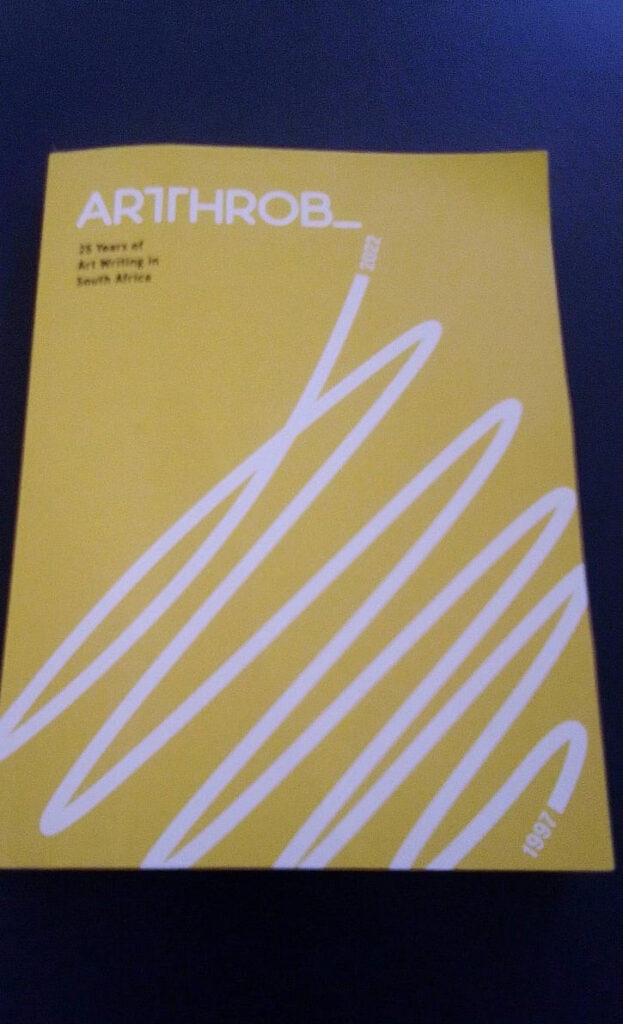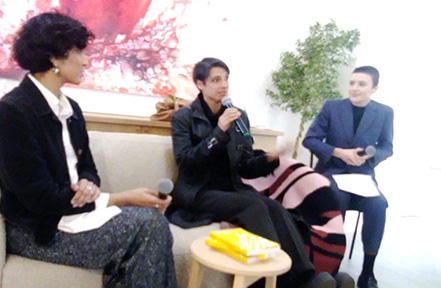Launch of ArtThrob book opens discussions on issue of role and sustainability of arts publications in the country
The launch of ArtThrob: 25 Years of Art Writing in South Africa, took place at Stevenson Gallery in Parktown on Saturday, August 5, 2023. The book can be ordered on arthrob.co.za and costs R300.
(second page lead, use the three ladies pic as the main pic and the book cover. Caption: Art writers Dinika Govender and Ruth Sacks, and ArtThrob Editor Keely Shinners)
By Edward Tsumele, CITYLIFE/ARTS Editor
On Saturday after viewing an exhibition at a Parkwood, Johannesburg based gallery, whose opening I had missed this past week, I took a chance and went to the nearby Stevenson Gallery in Parktown North. I was uninvited but luckily I stumbled on an event that turned out to be a robust discussion on the state and status of art writing in the country.
The discussion was in relation to the contemporary art scene in South Africa in general and the state and status of art writing in particular. The discussion however morphed into discussing the important role that specialist arts publications play in narrating the art story and how that assists in keeping the visual art scene vibrant and develop the careers of artists at a time when the mainstream media has taken a back seat on writing about the arts.
This is also as these publications struggle to be self-sustaining in the absence of adequate support from the private sector either through funding or advertising as well as that of the Department of Sports, Arts and Culture (DSAC) and its arts funding agencies. More about that later. The occasion was the launch of a book of essays about art by contributing writers to the art website ArtThrob, started by veteran artist and writer Sue Williams in 1997 after the Second Johannesburg Biennale.
The essays span 25 years of the publication’s existence and carries weight in that it is a record of the art scene for the past 25 years in South Africa. The essays numbering around 60 pieces are by various contributors, including academics, curators students and artists who review art exhibitions, biennales and art fairs among other subjects.
The variety of writing styles and in some cases, even stimulating intellectual discourses on the state and status of art during the period under review make this book a must have book, especially for those interested in the contemporary art scene in South Africa in the past 25 years. Those who might find this book an essential resource include art collectors, students and the general public wishing to catch up on the country’s artistic output.

ARTTHROB: 25 Years of Art Writing in South Africa, is also a resource for researchers in the field of art. Among the contributors, you will find well-known names, such as Sue Williams, who besides writing the foreword, also has quite insightful articles in the book, such as her detailed coverage of the Johannesburg Biennale in 1997. Her coverage is quite a compelling reading experience, especially for those who may have missed the biennale. I for one missed it, and reading her review of what went on there I found myself updated on that major art event that took place three years after the country attained freedom in 1994.
Keely Shinners the editor of ArtThrob clearly had a hard job of deciding which articles to include and unfortunately which ones to leave out for the sake of the limiting issue of space out of the several contributions by several writers. I do not admire her job as far as that is concerned. As editor of CITYLIFE/ARTS I find myself in that difficult position to for example choose which stories to cover and which ones to leave out, mainly due to the issue of time and also limited resources a difficult position so many other publications also find themselves in the arts sector. Sometimes it is heart breaking to exclude certain deserving stories for the reasons I have given above.
“Now, I should probably share some notes on my methodology: over six months, I read every single article ever published on ArtThrob, keeping track of those that felt interesting to me. The reason why this book is organised chronologically, as opposed to thematically, is to capture the sense of serendipitous discovery I felt as I journeyed my way through the archive. I then sifted through those and pulled out those I felt stood out of the traditional ‘review’ to take a temperature of the broader social, political and art historical climate,” she writes.
What Shinners is talking about here are article such as the painful demise of the Market Theatre Gallery, an account well narrated by its former manager artist Stephen Hobbs, who witnessed funding dry up till the gallery closed down in 2000.
Shinners is also talking about articles such as a review of an exhibition called Returning the Gaze by Blac, a collective of Cape Town based black artists at the Cape Town Festival in October 2000, written by Mgcineni Sobopha in which the artists including Thembinkosi Goniwe, now an associate professor at Rhodes University, wanted to make the point of positioning whiteness as an object and not as a subject as is usually the case. Shinners is also talking about articles such as the one written by Emma Bedford, who covered DAk/Art in Senegal in 2000, who does not only speak about the politics around that biennale but also how hard it was to travel from Cape to Dakar in Senegal, even longer than travelling to France or London from South Africa as she had to travel from Cape Town to Johannesburg, then fly through Kinshasa in the DRC, via Abidjan and Bamako, taking 20 hours.
However at the book launch on Saturday, the discussants arts writers who are also contributors to ArtThrob, Dinika Govender and Ruth Sacks, with Shinners as moderator spoke about the difficulties faced by both arts writers and specialist art publications in the country, particularly when it comes to their financial health and a general lack of support by corporates, unfortunately including puzzlingly those in the arts sector.
Not to speak about government, specifically the department of Arts and Culture and its dysfunctional arts funding agencies, such as the seemingly clueless National Arts Council and The National Lottery, which until recently saw money meant for arts funding such things as conference centres, plots and houses of the corrupt within the National Lottery itself and within the arts sector.
The National Arts Council’s shenanigans never stop to amaze as a research paper produced by the Campaign for Free Expression of which I was a co-author paints a damning picture of the public arts funding environment in general and at the NAC in particular. The paper was launched at Wits University in March and can be found on the NGO’s website for those interested in the research findings.
Though there is no doubt that specialist arts publication such as ArtThrob, Creative Feel, Johannesburg in Your Pocket, Art Africa band and of course this publication CITYLIFE/ARTS, play an important role in developing audiences and market for artistic output, especially because the mainstream media have left that space as they also fight for survival, these publications are not adequately supported financially. Not much from the private sector and Zero from the government, especially its arts funding agencies who seem to be oblivious to the important work these publications do in the arts sector. The discussants bemoaned this lack of support.
“As writers we always have to have a second job to sustain ourselves. The rates we get paid are not consistent, and right I no longer know my rate for my writing contribution,” complained Govender.
But the reality for these arts publications is despite the lack of financial support, they have increasingly become the mainstream publications in the art sector, occupying the vacuum left by the traditional media which over the years has shifted to cover popular areas such as celebrity news, sport and politics, with every single paper that once had an arts supplement either having closed those down or now covering lifestyle and not art.
These arts publication have therefore taken that space and have a captive audience that they no longer share with traditional media. And so the increasing numbers of the readership these specialist publications have is the one thing that sees them continue to publish. Some of them are actually growing. Personally I have witnessed how CITYLIFE/ARTS after going online in 2020 instead of its original business model that was a print version distributed for free art spaces, grew exponentially. Its current footprint besides South Africa being where it biggest readership now has a footprint, counting solid readership in the US, UK and Asia, while on the African continent besides South Africa, the publication has a significant readership Botswana, Zimbabwe, Mozambique and Kenya. Overall the publication is read in over 90 countries.
I am sure the other specialist publications in the sector have similar stories of global success to tell as the world gives Africa a gaze, to spot the next emerging artist to take note of and possibly collect from the African continent.
What is at issue as the discussants elaborated on is the issue of sustainability in a situation where there is lack of enough financial support from the private sector and the government arts funding agencies for the only few publications doing incredible work in supporting what South African creatives produce for the market.
“For ArtThrob we approach certain artists to donate limited editions of prints that we sell and out of this we then pay our writers and the salaries of staff. We sell mostly at an art fair and that happens once a year often covering the expenses for that year. And so it is a hand to mouth situation, making it difficult to plan beyond one year. However we are grateful to the artists and galleries for their collaboration,” said Shinners in answer to a question from an audience member who wanted to know about the publication’s sustainability.
One audience member offered another option by way of a question.
“Perhaps the question we should ask ourselves as artists is: What is it that we are doing as artist to support these publications which clearly support our careers and art practice.”
Perhaps the question should be what is it that the Department of Arts, Culture and Sport and its arts funding agencies like the National Arts Council are doing to0 support such independent publications whose work is essential for the development of the arts sector in the country. It is not as if for example a grant of R5 million disbursed to be shared by the publications above will make the government broke. If anything it will make the work of the publications easier as they upscale their coverage of the arts, employ more young writers while achieving financial stability and sustainability.











Thanks for this. A fascinating subject. I worked as an arts reporter for years at a large mainstream SA paper that I don’t think covers much arts any more. And fabulous to hear you are being read in 90 countries.